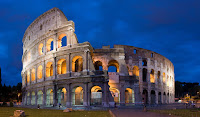Roman
Art
-Ancient
Roman architecture adopted many different aspects of Ancient Greek
architecture, to creating a new architectural style.
-The
Romans were known to employ Greek craftsmen and engineers to construct Roman
buildings.
-Roman
architecture flourished throughout the Empire during the Pax Romana.
-Roman
Architecture covers the period from the establishment of the Roman Republic in
509BC.
-Roman
architectural style continued to influence building in the former empire for
many centuries, and it is called Romanesque architecture to reflect this
dependence on basic Roman forms.
-Aqueducts
of Rome, the Baths of Diocletian and the Baths of Caracalla, the basilicas .
-They
were reproduced at smaller scale in most important towns and cities in the
Empire.
-Some
surviving structures are almost complete, such as the town walls of Lugo in
Hispania Tarraconensis, or northern Spain.
-The
Ancient Romans, public buildings should be made to impress, as perform a public
function.
-The
dome permitted construction of vaulted ceilings without crossbeams and provided
large covered public space such as public baths and basilicas.
-The
Romans based much of their architecture on the dome, such as Hadrian's Pantheon
in the city of Rome, the Baths of Diocletian and the Baths of Caracalla.
-Art
historians such as Gottfried Richter in the 1920s identified the Roman
architectural innovation as being the Triumphal Arch.
-This
symbol of power was transformed and utilised within the Christian basilicas when
the Roman Empire of the West was on its last legs.
-The
Romans first adopted the arch from the Etruscans, and implemented it in their
own building.
-An
arch transmits load evenly and is still commonly used in architecture today.
-The
Ancient Romans were responsible for significant developments in housing and
public hygiene.
-For
example their public and private baths and latrines, under-floor heating in the
form of the hypocaust, piped hot and
cold water .
-Ancient
Rome is had elaborated, massive and beautiful houses and buildings.
-These
houses and buildings belonged to those in higher social status.
-The
average house of a commoner or Plebe did not contain many luxuries.
-There
were members of the upper class that attended to flash their wealth into their
design.
-All
Roman cities had at least one Thermae, a popular facility for public bathing,
exercising and socializing.
-Exercise
might include wrestling and weight-lifting as swimming.
-Bathing
was an important part of the Roman day, where some hours might be spent, at a
very low cost subsidized by the government.
-Roman
bath-houses were provided for private
villas, town houses and forts.
-They
were normally supplied with water from an adjacent river or stream, or by
aqueduct.
-Many
lighthouses were built around the Mediterranean and the coasts of the empire.
-
A smaller lighthouse at Dover, England also exists as a ruin about half the
height of the original.
-The
light would have been provided by a fire at the top of the structure.
-Tile
covered concrete quickly supplanted marble as the primary building material.
-The
freedom of concrete also inspired the colonnade screen, a row of purely
decorative columns in front of a load-bearing wall.
-
In smaller-scale architecture, concrete's strength freed the floor plan from
rectangular cells to a more free-flowing environment.
-Although
concrete had been used on a minor scale in Mesopotamia.
-The first use of concrete by the Romans was
in the town of Cosa sometime after 273 BCE.
-
Ancient Roman concrete was a mixture of lime mortar, sand with stone rubble and
stones.
-When
the framework was removed, the new wall was very strong with a rough surface of
bricks or stones.
-The
wooden frames could be used more than once, allowing builders to work quickly
and efficiently.
The Colosseum in Rome
Italy,Hadrian's Wall
The Roman Forum



No comments:
Post a Comment